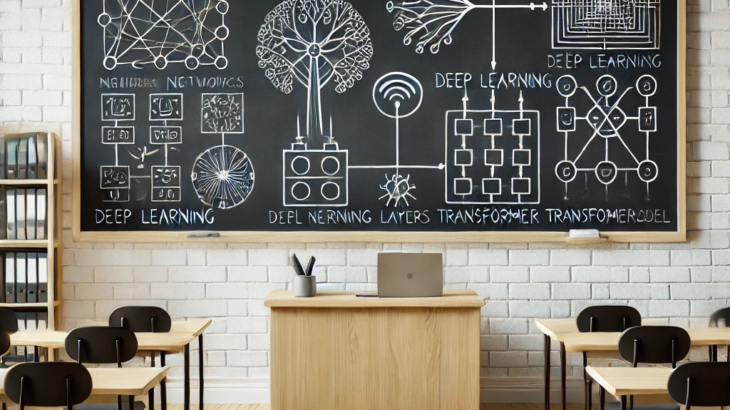Classification is a type of machine learning task where you predict a category (or label) rather than a continuous number. For example, classifying whether an email is spam or not is a classification task, because the output is categorical (spam or not spam), not a continuous number.
Neural Networks: The Building Blocks
Neural networks are a type of machine learning model that mimics the way the human brain works. They are made up of layers of “perceptrons,” which are like the brain’s neurons.
What is a Perceptron?
A perceptron is a simple unit that takes inputs (such as numbers), multiplies each by a weight (which represents the importance of that input), and sums them up. After adding an intercept (a constant), the perceptron applies a decision rule or function to produce an output—usually either 0 or 1.
Traditional perceptrons used a simple step function that would output a 1 if the sum was above a certain threshold, and 0 otherwise. Modern neural networks, however, use more complex functions like:
- Sigmoid: Produces outputs between 0 and 1.
- Tanh: Outputs values between -1 and 1.
- ReLU (Rectified Linear Unit): Outputs the input if it’s positive, otherwise returns 0.
These activation functions allow neural networks to learn more complex patterns in data.
Deep Learning: Going Deeper
Deep learning is a subset of neural networks but with a key difference: depth. While a simple neural network might have one hidden layer, a deep learning model has multiple hidden layers stacked one after the other. Each layer passes information to the next, allowing the model to learn intricate, hierarchical patterns in data.
The deeper the network, the more it can learn from the data, making deep learning highly effective for tasks like image recognition, language processing, and game playing.
Recurrent Neural Networks (RNN): Learning from Sequences
While standard neural networks treat each input independently, Recurrent Neural Networks (RNNs) are designed to work with sequences of data, like time-series data, text, or audio.
What makes RNNs special is their ability to “remember” information over time. They do this by feeding the output of one time step back into the network as input for the next time step. This allows them to capture temporal dependencies in data, such as the structure of a sentence or the pattern of stock prices.
Long Short-Term Memory (LSTM):
A popular variant of RNNs is the Long Short-Term Memory (LSTM) network. LSTMs are specifically designed to avoid the problem of forgetting important information over long sequences. They achieve this by introducing gates:
- Input gate: Controls what information to add from the current input.
- Forget gate: Decides what information to throw away from previous steps.
- Output gate: Determines what information should be passed to the next time step.
These gates help LSTMs maintain long-term dependencies, which is why they’re widely used in tasks like language translation and speech recognition.
Transformers and Foundation Models: The Next Evolution
Deep learning has paved the way for Transformer models, which are now the backbone of state-of-the-art AI systems. Transformer models, also known as foundation models, have revolutionized the way we handle language, images, and other complex data.
Let’s look at some of the most influential Transformer models:
- BERT (Bidirectional Encoder Representations from Transformers)
Developed by Google, BERT excels at understanding the context of words in a sentence by reading text in both directions (left to right and right to left). This allows BERT to perform tasks like answering questions or classifying text more effectively. - GPT (Generative Pretrained Transformer)
GPT models, created by OpenAI, are famous for their ability to generate human-like text. They can write essays, answer questions, and even generate code. GPT models like GPT-4 are trained on massive amounts of text and can produce surprisingly coherent and contextually accurate responses. - T5 (Text-to-Text Transfer Transformer)
Google’s T5 reframes all natural language processing (NLP) tasks as a text-to-text problem. Whether it’s translating languages, summarizing articles, or classifying sentiment, T5 treats every task as input text leading to output text, simplifying the model’s training.
Transformers in Image Generation
Transformers aren’t limited to text—they’ve also made a huge impact on image generation.
- DALL·E 2 (OpenAI)
DALL·E 2 is a Transformer model designed to generate images from text prompts. It can create incredibly detailed and coherent images by understanding the relationships between words and visual elements. - Stable Diffusion
Stable Diffusion is a powerful image generation model that uses a process called latent diffusion to gradually generate images. It can create highly customizable and detailed artwork based on text descriptions and is more flexible than models like DALL·E in terms of user control. - LaMDA (Language Model for Dialogue Applications)
Developed by Google, LaMDA is a Transformer model specifically fine-tuned for engaging in conversations. Unlike other models that excel at single tasks, LaMDA is designed to carry on open-ended, natural dialogue on almost any topic.
What Makes Transformers Special?
Transformer models can predict all kinds of things—from the next word in a sentence to pixels in an image. This prediction ability can be extended to generation, where models create new text, images, or even entire pieces of art from scratch.
What makes Transformers so powerful is their ability to handle large amounts of data and learn complex patterns. Trained on massive datasets, these models can even perform well on tasks they’ve never seen before, a phenomenon known as zero-shot learning.
Conclusion
From simple neural networks to deep learning and cutting-edge Transformers, AI models are becoming increasingly sophisticated. They can understand language, generate art, and engage in conversations with humans, all thanks to their ability to learn complex patterns and relationships. As these technologies continue to evolve, their impact on everything from business to education and entertainment will only grow.
Reference:
Baker, R.S. (2024) Big Data and Education. 8th Edition. Philadelphia, PA: University of Pennsylvania.










